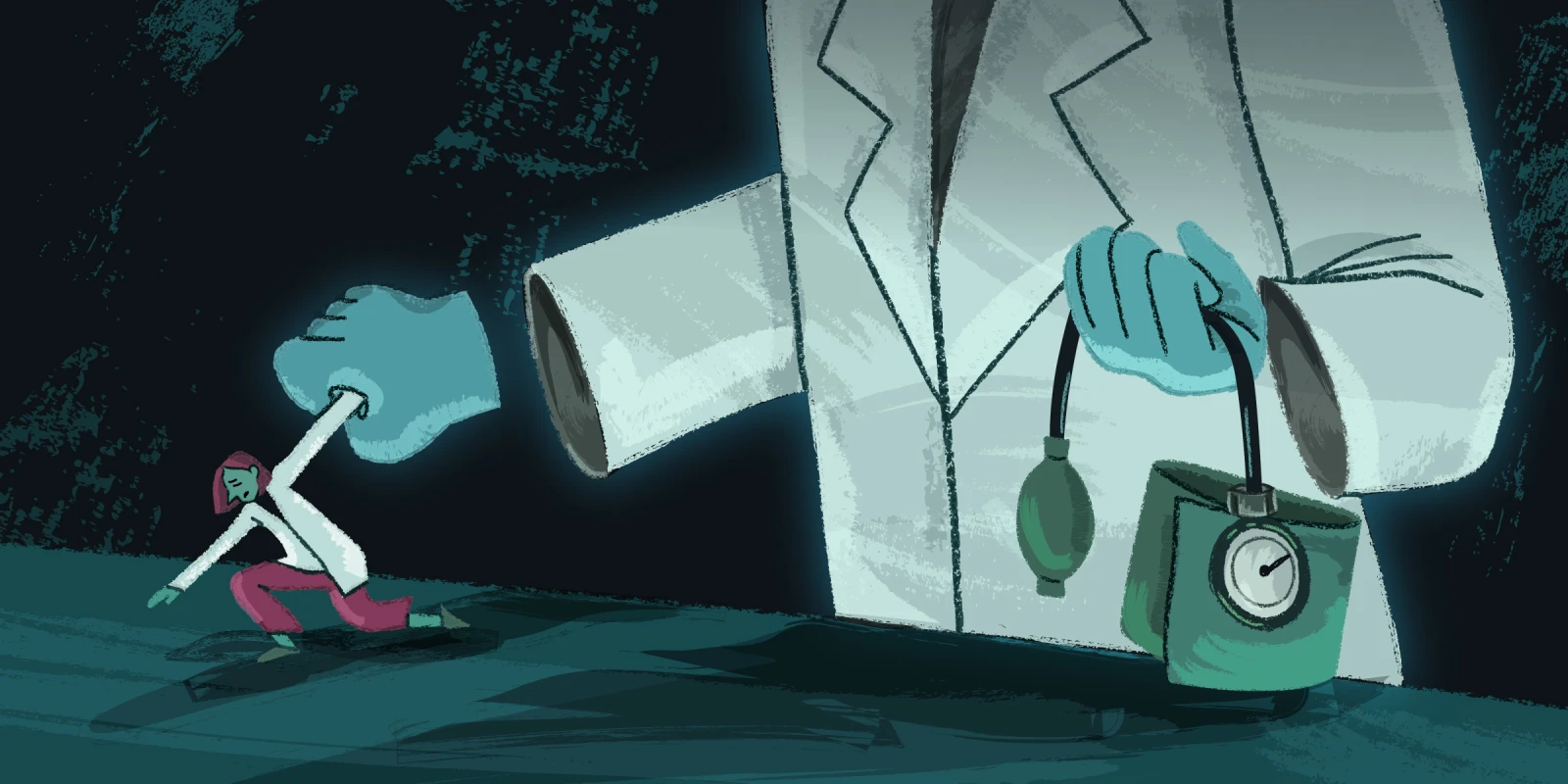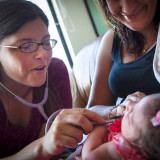“How does the big brother feel about the baby?” asked the nurse conversationally. We chatted while she went through her usual routine. Wrapping the blood pressure cuff around my arm, she commented, “Well, I hope it isn’t high, then you wouldn’t be allowed to have your baby here.”
I didn’t think too much about it. My blood pressure had always been at the low end of normal, nothing close to what would get me booted from the freestanding birth center that I’d chosen for my second pregnancy.
“Hmm,” she said. “Let me just check that again. It’s higher than it was at your last visit. We don’t want to see it creeping up.”
Well, no, I didn’t want to see it creeping up either. Besides the knowledge of pre-eclampsia and various pregnancy complications I’d seen firsthand, I had my heart set on delivering at the birth center that was within an easy bike ride from my house. I had my first baby at the small community hospital where I trained, surrounded with people I knew, attended by my very favorite nurse and the doctor whom I’d seen work miracles saving babies no one thought would survive. I'd felt almost safe, cared for entirely by people who I knew wouldn't hurt me. Moving back home to the city, I was confronted with having to choose between various large hospitals with a constantly rotating staff of strangers whom I couldn’t trust. The birth center felt cozier, more familiar, safer. I knew that I had to meet all the criteria to deliver there.
The recheck turned out to be higher than the initial blood pressure. “I’ll just let you sit here and relax for a minute and then I’ll check again,” she said. “I want to give you every chance to bring it down.”
This was it. It was like failing an exam and being given an opportunity to retake it. I had a chance to redeem myself, to bring down that shamefully high blood pressure and prove that I had what it took to be allowed to deliver at the birth center.
It was a familiar feeling for me … except for the failing. I'd always made sure I never failed. I’d learned long ago that the only way to feel safe was to impress the people around me, to be good enough to be allowed into the places where I knew I didn’t really belong. If I didn’t meet expectations, I could be thrown back into the chaos of my childhood, I could lose control of what would happen to me next and just have to white-knuckle it through life. But I’d also spent my life learning what it took to be in charge of my own circumstances. I’m resilient and tenacious. I’ve become the kind of person who will keep trying, no matter what.
But it turns out that no amount of hard work can lower a blood pressure that’s been raised by the fear of losing safety and control. Through that pregnancy and the intervening years since, I've managed to maintain an impressive 220/120 blood pressure when checked at a medical facility.
The kind nurse with soft warm hands, whom I saw years later and only once, was able to get a close-to-normal reading. “I don’t know why we check this since the doctor never looks at it,” she commented as I set my things on the shelf and took off my sweater. “I’m just so glad you’re here today. He’ll get your lab work sorted out. Everyone leaves here feeling better because he sits down with you and explains everything, lets you decide what you want to do, and you leave with a plan. I love working in an office where the doctor cares so much.” And I loved her soothing voice with a slightly European accent, like my Prussian grandma’s, and her reassurance that the doctor cared about his patients, would take his time, would give me choices. Most of all, he wouldn’t be judging me based on my blood pressure. I could relax and trust him. And so, my blood pressure came down.
But everywhere else I went, I learned the routine. The busy assistant would rush me back, check my blood pressure before I’d caught my breath from the walk into the office, look worried, check again, tell me to sit and think about it, check again and announce, “Well, I’m going to have to tell the doctor about this one.”
The doctor would look at me with a furrowed brow and tell me that if my blood pressure was high when they checked it, it’s probably high other times that I’m anxious, too. I'd try to explain that they were the problem. That I’m scared of losing control of what happens to me. That I’d tried taking a blood pressure medication and couldn’t stand up without getting lightheaded because, in reality, my blood pressure is actually fine. Moreover, the medication hadn't changed the in-office blood pressure at all. A physiological response to trauma can easily override a mere pharmaceutical. I desperately pleaded for myself; having broken the cardinal rule to always be perfect, would they please not be mad at me? Would they please just leave me alone?
My PCP eventually listened but kept worrying about me. She clearly didn’t believe me when I told her that I’m usually fine, that it’s only the act of checking my blood pressure, the fear of what she'll do to me, that has me completely freaked out. Granted, I don’t look freaked out. My earliest memories are of both terror and pulling myself together, knowing that I’d only make things worse if I let myself slip up — I’ve a lifetime of hiding my feelings. I can split myself into the part flooded with unbearable fear and the part exuding calm in order to get control of an out-of-control situation. I don’t even know how to look scared.
As my in-office blood pressures careened out of control, I avoided medical care as much as possible. I’d chosen a home birth out of fear of what would happen if I couldn’t somehow wrestle my blood pressure into submission. Safely at home, without the fear, my blood pressure dropped immediately and stayed normal throughout the pregnancy. That turned out alright but seven months after my daughter’s birth, I ignored the dramatic symptoms of a torn artery and subsequent stroke until I’d had a second stroke and had to be taken to the hospital from work. A few years later, I downplayed early warning bleeding until I ended up in an ambulance with a hemorrhage. It was watching my own blood fill the suction basin that convinced me that I needed to overcome my fear at least enough to see my PCP for anything unusual. But every time I went in, I became the terrified child, somehow managing to put one foot in front of the other to walk right into the scary situation.
And then my latest therapist, who had been trained in trauma-informed care, reminded me of a fact I’d completely forgotten: I have the right to refuse. I can refuse to have my blood pressure checked. I can refuse to have it treated. I didn’t have to convince anyone of anything. I’m an adult with full agency over what happens to my body.
I changed my PCP to a colleague who practices trauma-informed care and trusts me to make my own decisions. She confidently steps aside into the role of advisor, allowing me to be in charge of myself. I’d been so comfortable talking with her professionally that she already knew more of my story than most people do, and she never treated me differently because of it, except maybe to be a little extra helpful and understanding. And she had confided enough of her own struggles that I knew she understood and believed me.
My daughter, who was forming inside of me when all of this started, now happily rides the bus to fourth grade every day — it has been nine years, and I’m still afraid of having my blood pressure checked. But I’m healing. Now, I cuddle up with her on the sofa and check my blood pressure while we sit nose-to-nose; I’m slowly training my body that it has nothing to fear from a simple screening.
My daughter doesn’t know about my fear of medical care. She confidently walks into appointments and gives her own medical history. She asks questions about the risks, benefits, and alternatives and makes her own choices (with some help from me). Watching what it’s like to be whole and unbroken, I feel sad that I’ll never have what she has. I’ll always wear the scars from problems that started when I was much younger than her. At the same time, I’m proud of how far I am from where I was. I’m proud that I did the hard work to heal enough that I have not handed down my brokenness to my child.
Every year when I teach the medical students about trauma-informed care, I’m flooded again by my own fear, even while I’m helping them understand how to not retraumatize patients like me. And every year, I receive texts and emails from students thanking me for what I’m doing. Telling me that they started seeing a therapist because of me. Or that they stopped judging people whose lives were so much harder than their own.
You never know who has broken bits on the inside, or healed places that are still very sensitive. Just as universal precautions protect everyone from unsuspected pathogens, by assuming that each person is more likely to have hidden traumas than not, we protect against unintended harm. It takes every person in a system to fix the world, but one person can make all the difference in one patient’s life. If we each do our part to heal our own wounds, and to learn to care for others, we can create a medical experience that closes the loop of trauma and opens a new path to health.
Have you ever had a negative encounter as a patient? Did it change anything about how you practice as a physician? Share your experience in the comments.
Robin Dickinson, MD is a board-certified family physician who teaches clinical skills to first-year students at Rocky Vista University. She created the first pre-medical curriculum for kids, hosts a podcast for young people who want to be physicians, consults neurodiverse families and individuals, and founded the only free clinic and the first DPC practice in her hometown. You can find her at robindickinsonmd. Dr. Dickinson is a 2021–2022 Doximity Op-Med Fellow.
Illustration by Diana Connolly







